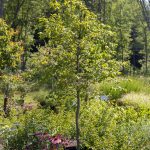A shade tree is any deciduous tree that grows to at least 50’ at its mature height and provides space beneath its canopy. Here are some of the more common ones hardy for upstate New York:
- Maples
- Weeping Maples
- Japanese Maples
- Black Gums
- Sweet Gums
- Weeping Willows
- Clump River Birches
While any tree can provide benefits for your landscape, shade trees arguably give back the most in terms of money saved, property value raised, and beauty added.
Energy Costs: Planting a shade approximately 20’ from the east, west, or North West side of your home can provide shade to your house and save you up to $250 in air conditioning costs per year, according to the U.S. Department of Energy. Shading air conditioning units also reduces your energy costs.
Value: Good landscaping – especially when it incorporates mature trees – can raise your property’s resale value by up to 20% (via Arborday.org). If you have a commercial property, statistically speaking, people are more likely to stay longer and spend more money on a property with mature trees.
Environmental Benefits: A shade tree with a lifespan of 50 years can provide over $62,000.00 worth of air pollution control, provide $31,200.00 in oxygen, and recycle up to $37,500.oo worth of water.
And those are just the hard facts – time and again, studies show that the presence of trees on any landscape can help improve people’s moods and feeling of well-being.
When it comes to finding the right tree, it really depends on your lifestyle and the type of landscape you have. Willow trees will thrive in wetter areas, but maples prefer well-drain soiled. Ask your local nursery manager about what kinds of trees are best suited to your landscape.
Location is also dependent on what you’re looking for. To reap the energy benefits of a shade tree, plant the tree about twenty feet from east, north or northwest facing windows of your home, or so that the canopy will ultimately shade any air conditioning units. If you’re looking to make the most of the under canopy area, consider planting one near a patio or outdoor living area to get a break from the summer sun.
Have a question? Give us a call or shoot us an email and we’ll be happy to help.
- Sweet Gum
- Black Gum
- Japanese Maple







